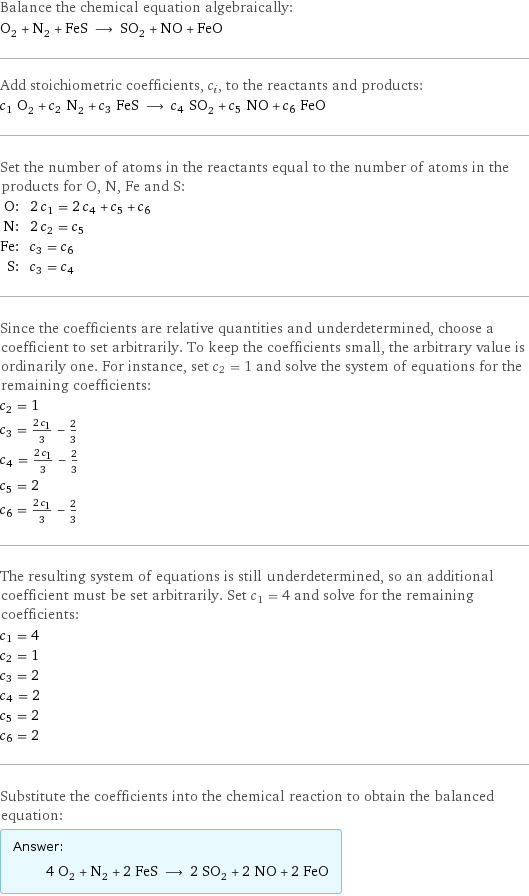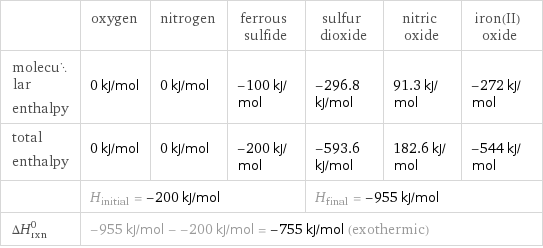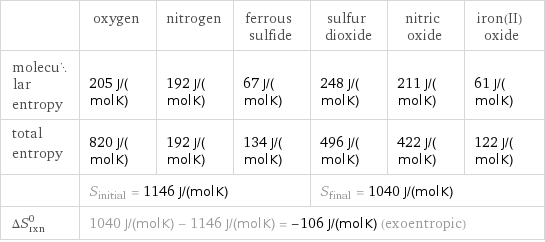Input interpretation

O_2 oxygen + N_2 nitrogen + FeS ferrous sulfide ⟶ SO_2 sulfur dioxide + NO nitric oxide + FeO iron(II) oxide
Balanced equation

Balance the chemical equation algebraically: O_2 + N_2 + FeS ⟶ SO_2 + NO + FeO Add stoichiometric coefficients, c_i, to the reactants and products: c_1 O_2 + c_2 N_2 + c_3 FeS ⟶ c_4 SO_2 + c_5 NO + c_6 FeO Set the number of atoms in the reactants equal to the number of atoms in the products for O, N, Fe and S: O: | 2 c_1 = 2 c_4 + c_5 + c_6 N: | 2 c_2 = c_5 Fe: | c_3 = c_6 S: | c_3 = c_4 Since the coefficients are relative quantities and underdetermined, choose a coefficient to set arbitrarily. To keep the coefficients small, the arbitrary value is ordinarily one. For instance, set c_2 = 1 and solve the system of equations for the remaining coefficients: c_2 = 1 c_3 = (2 c_1)/3 - 2/3 c_4 = (2 c_1)/3 - 2/3 c_5 = 2 c_6 = (2 c_1)/3 - 2/3 The resulting system of equations is still underdetermined, so an additional coefficient must be set arbitrarily. Set c_1 = 4 and solve for the remaining coefficients: c_1 = 4 c_2 = 1 c_3 = 2 c_4 = 2 c_5 = 2 c_6 = 2 Substitute the coefficients into the chemical reaction to obtain the balanced equation: Answer: | | 4 O_2 + N_2 + 2 FeS ⟶ 2 SO_2 + 2 NO + 2 FeO
Structures

+ + ⟶ + +
Names

oxygen + nitrogen + ferrous sulfide ⟶ sulfur dioxide + nitric oxide + iron(II) oxide
Reaction thermodynamics
Enthalpy

| oxygen | nitrogen | ferrous sulfide | sulfur dioxide | nitric oxide | iron(II) oxide molecular enthalpy | 0 kJ/mol | 0 kJ/mol | -100 kJ/mol | -296.8 kJ/mol | 91.3 kJ/mol | -272 kJ/mol total enthalpy | 0 kJ/mol | 0 kJ/mol | -200 kJ/mol | -593.6 kJ/mol | 182.6 kJ/mol | -544 kJ/mol | H_initial = -200 kJ/mol | | | H_final = -955 kJ/mol | | ΔH_rxn^0 | -955 kJ/mol - -200 kJ/mol = -755 kJ/mol (exothermic) | | | | |
Gibbs free energy

| oxygen | nitrogen | ferrous sulfide | sulfur dioxide | nitric oxide | iron(II) oxide molecular free energy | 231.7 kJ/mol | 0 kJ/mol | -100.4 kJ/mol | -300.1 kJ/mol | 87.6 kJ/mol | -255 kJ/mol total free energy | 926.8 kJ/mol | 0 kJ/mol | -200.8 kJ/mol | -600.2 kJ/mol | 175.2 kJ/mol | -510 kJ/mol | G_initial = 726 kJ/mol | | | G_final = -935 kJ/mol | | ΔG_rxn^0 | -935 kJ/mol - 726 kJ/mol = -1661 kJ/mol (exergonic) | | | | |
Entropy

| oxygen | nitrogen | ferrous sulfide | sulfur dioxide | nitric oxide | iron(II) oxide molecular entropy | 205 J/(mol K) | 192 J/(mol K) | 67 J/(mol K) | 248 J/(mol K) | 211 J/(mol K) | 61 J/(mol K) total entropy | 820 J/(mol K) | 192 J/(mol K) | 134 J/(mol K) | 496 J/(mol K) | 422 J/(mol K) | 122 J/(mol K) | S_initial = 1146 J/(mol K) | | | S_final = 1040 J/(mol K) | | ΔS_rxn^0 | 1040 J/(mol K) - 1146 J/(mol K) = -106 J/(mol K) (exoentropic) | | | | |
Equilibrium constant
![Construct the equilibrium constant, K, expression for: O_2 + N_2 + FeS ⟶ SO_2 + NO + FeO Plan: • Balance the chemical equation. • Determine the stoichiometric numbers. • Assemble the activity expression for each chemical species. • Use the activity expressions to build the equilibrium constant expression. Write the balanced chemical equation: 4 O_2 + N_2 + 2 FeS ⟶ 2 SO_2 + 2 NO + 2 FeO Assign stoichiometric numbers, ν_i, using the stoichiometric coefficients, c_i, from the balanced chemical equation in the following manner: ν_i = -c_i for reactants and ν_i = c_i for products: chemical species | c_i | ν_i O_2 | 4 | -4 N_2 | 1 | -1 FeS | 2 | -2 SO_2 | 2 | 2 NO | 2 | 2 FeO | 2 | 2 Assemble the activity expressions accounting for the state of matter and ν_i: chemical species | c_i | ν_i | activity expression O_2 | 4 | -4 | ([O2])^(-4) N_2 | 1 | -1 | ([N2])^(-1) FeS | 2 | -2 | ([FeS])^(-2) SO_2 | 2 | 2 | ([SO2])^2 NO | 2 | 2 | ([NO])^2 FeO | 2 | 2 | ([FeO])^2 The equilibrium constant symbol in the concentration basis is: K_c Mulitply the activity expressions to arrive at the K_c expression: Answer: | | K_c = ([O2])^(-4) ([N2])^(-1) ([FeS])^(-2) ([SO2])^2 ([NO])^2 ([FeO])^2 = (([SO2])^2 ([NO])^2 ([FeO])^2)/(([O2])^4 [N2] ([FeS])^2)](../image_source/f9360a87d8023021d655e22997c0f1be.png)
Construct the equilibrium constant, K, expression for: O_2 + N_2 + FeS ⟶ SO_2 + NO + FeO Plan: • Balance the chemical equation. • Determine the stoichiometric numbers. • Assemble the activity expression for each chemical species. • Use the activity expressions to build the equilibrium constant expression. Write the balanced chemical equation: 4 O_2 + N_2 + 2 FeS ⟶ 2 SO_2 + 2 NO + 2 FeO Assign stoichiometric numbers, ν_i, using the stoichiometric coefficients, c_i, from the balanced chemical equation in the following manner: ν_i = -c_i for reactants and ν_i = c_i for products: chemical species | c_i | ν_i O_2 | 4 | -4 N_2 | 1 | -1 FeS | 2 | -2 SO_2 | 2 | 2 NO | 2 | 2 FeO | 2 | 2 Assemble the activity expressions accounting for the state of matter and ν_i: chemical species | c_i | ν_i | activity expression O_2 | 4 | -4 | ([O2])^(-4) N_2 | 1 | -1 | ([N2])^(-1) FeS | 2 | -2 | ([FeS])^(-2) SO_2 | 2 | 2 | ([SO2])^2 NO | 2 | 2 | ([NO])^2 FeO | 2 | 2 | ([FeO])^2 The equilibrium constant symbol in the concentration basis is: K_c Mulitply the activity expressions to arrive at the K_c expression: Answer: | | K_c = ([O2])^(-4) ([N2])^(-1) ([FeS])^(-2) ([SO2])^2 ([NO])^2 ([FeO])^2 = (([SO2])^2 ([NO])^2 ([FeO])^2)/(([O2])^4 [N2] ([FeS])^2)
Rate of reaction
![Construct the rate of reaction expression for: O_2 + N_2 + FeS ⟶ SO_2 + NO + FeO Plan: • Balance the chemical equation. • Determine the stoichiometric numbers. • Assemble the rate term for each chemical species. • Write the rate of reaction expression. Write the balanced chemical equation: 4 O_2 + N_2 + 2 FeS ⟶ 2 SO_2 + 2 NO + 2 FeO Assign stoichiometric numbers, ν_i, using the stoichiometric coefficients, c_i, from the balanced chemical equation in the following manner: ν_i = -c_i for reactants and ν_i = c_i for products: chemical species | c_i | ν_i O_2 | 4 | -4 N_2 | 1 | -1 FeS | 2 | -2 SO_2 | 2 | 2 NO | 2 | 2 FeO | 2 | 2 The rate term for each chemical species, B_i, is 1/ν_i(Δ[B_i])/(Δt) where [B_i] is the amount concentration and t is time: chemical species | c_i | ν_i | rate term O_2 | 4 | -4 | -1/4 (Δ[O2])/(Δt) N_2 | 1 | -1 | -(Δ[N2])/(Δt) FeS | 2 | -2 | -1/2 (Δ[FeS])/(Δt) SO_2 | 2 | 2 | 1/2 (Δ[SO2])/(Δt) NO | 2 | 2 | 1/2 (Δ[NO])/(Δt) FeO | 2 | 2 | 1/2 (Δ[FeO])/(Δt) (for infinitesimal rate of change, replace Δ with d) Set the rate terms equal to each other to arrive at the rate expression: Answer: | | rate = -1/4 (Δ[O2])/(Δt) = -(Δ[N2])/(Δt) = -1/2 (Δ[FeS])/(Δt) = 1/2 (Δ[SO2])/(Δt) = 1/2 (Δ[NO])/(Δt) = 1/2 (Δ[FeO])/(Δt) (assuming constant volume and no accumulation of intermediates or side products)](../image_source/08bc7b7db0bd32a9ae8eb9bec8c16217.png)
Construct the rate of reaction expression for: O_2 + N_2 + FeS ⟶ SO_2 + NO + FeO Plan: • Balance the chemical equation. • Determine the stoichiometric numbers. • Assemble the rate term for each chemical species. • Write the rate of reaction expression. Write the balanced chemical equation: 4 O_2 + N_2 + 2 FeS ⟶ 2 SO_2 + 2 NO + 2 FeO Assign stoichiometric numbers, ν_i, using the stoichiometric coefficients, c_i, from the balanced chemical equation in the following manner: ν_i = -c_i for reactants and ν_i = c_i for products: chemical species | c_i | ν_i O_2 | 4 | -4 N_2 | 1 | -1 FeS | 2 | -2 SO_2 | 2 | 2 NO | 2 | 2 FeO | 2 | 2 The rate term for each chemical species, B_i, is 1/ν_i(Δ[B_i])/(Δt) where [B_i] is the amount concentration and t is time: chemical species | c_i | ν_i | rate term O_2 | 4 | -4 | -1/4 (Δ[O2])/(Δt) N_2 | 1 | -1 | -(Δ[N2])/(Δt) FeS | 2 | -2 | -1/2 (Δ[FeS])/(Δt) SO_2 | 2 | 2 | 1/2 (Δ[SO2])/(Δt) NO | 2 | 2 | 1/2 (Δ[NO])/(Δt) FeO | 2 | 2 | 1/2 (Δ[FeO])/(Δt) (for infinitesimal rate of change, replace Δ with d) Set the rate terms equal to each other to arrive at the rate expression: Answer: | | rate = -1/4 (Δ[O2])/(Δt) = -(Δ[N2])/(Δt) = -1/2 (Δ[FeS])/(Δt) = 1/2 (Δ[SO2])/(Δt) = 1/2 (Δ[NO])/(Δt) = 1/2 (Δ[FeO])/(Δt) (assuming constant volume and no accumulation of intermediates or side products)
Chemical names and formulas

| oxygen | nitrogen | ferrous sulfide | sulfur dioxide | nitric oxide | iron(II) oxide formula | O_2 | N_2 | FeS | SO_2 | NO | FeO Hill formula | O_2 | N_2 | FeS | O_2S | NO | FeO name | oxygen | nitrogen | ferrous sulfide | sulfur dioxide | nitric oxide | iron(II) oxide IUPAC name | molecular oxygen | molecular nitrogen | | sulfur dioxide | nitric oxide | oxoiron